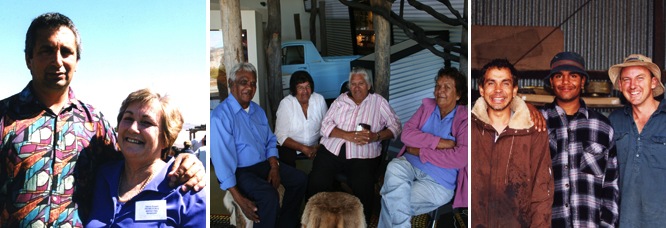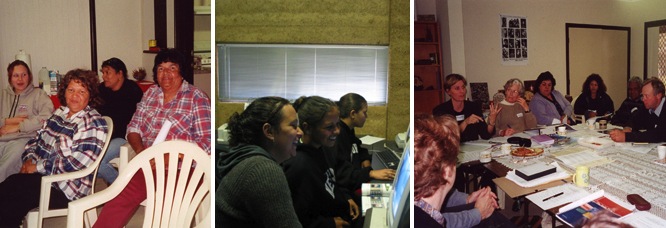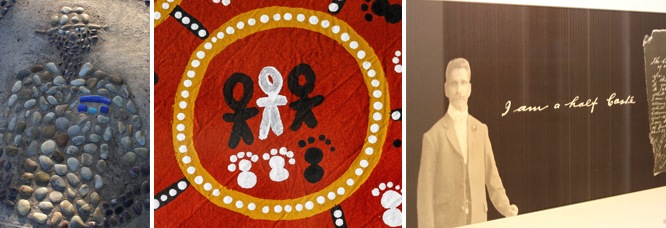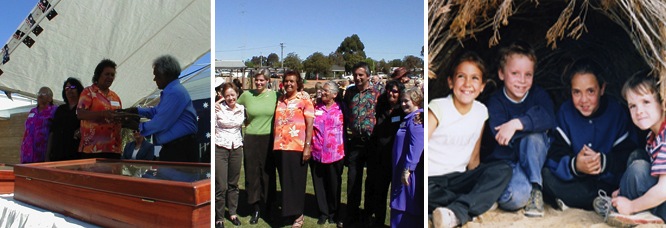
The Kodja Place built on existing (and fostered new) Noongar-Wadjela friendships; local Noongar Elders gathered at The Kodja Place for the ABC RN Life Matters show; working together – Noongar & Wadjela – on a local farm. Photos: left & right by Wendy Thorn; middle courtesy of ABC RN Life Matters.
The Kodja Place: A tool for reconciliation
Acknowledging the past and moving forward, together
Kojonup’s Noongar-Indigenous and Wadjela (non-Indigenous) communities worked together to create The Kodja Place. For several years we talked – at the Kojonup Aboriginal Centre, in the bush, in homes, on video shoots, in the Kodja Place kitchen, and at the footie – gradually building relationships and trust and gathering the stories and materials to include in the displays.
Evolving process
Initially, separate display spaces for local Noongar and Wadjela experiences and history were discussed, but the decision was made to tell the stories side-by-side. Craig McVee, Chairperson of the Kojonup Aboriginal Corporation, explains:
‘In the very early stages of The Kodja Place project, the Wadjelas, wishing to do the right thing and not upset anyone, asked if we preferred to display our history and culture separately. But as a group we decided that to move forward as “True Australians” we would tell our story alongside that of the Wadjelas.’
Download: Full text of the Chair’s opening speech. (PDF)
Over time, our collective talking produced more trust, insights and opportunities and the stories were intertwined, Noongar and Wadjela.

Community members gather at the Kojonup Aboriginal Centre for discussions about The Kodja Place displays; video editing underway at The Kodja Place. Photos: left by Emily Warburton; others by Penny Young.
Inclusive
Jointly we developed exhibition themes to cover multi-cultural points of view about the land, life and history in the Kojonup area. There was give and take over which stories to tell. We selected experiences and display materials that show our shared passions, such as family and sport, as well as differences, including the local impact of past government policies towards Indigenous Australians. We also explored the ways in which our communities have interacted and intertwined over time.
Local Noongar Brian Johns talked about his experience of working in a shearing shed:
‘It’s a place where anyone can work, from any culture. You’re part of a team, but it’s even closer, like a family.’
Acknowledging both the painful Noongar experiences following Wadjela settlement, and the Noongar community’s contributions to Kojonup’s development was enormously important to everyone involved with the project.
Responsive
Innovative storytelling and design approaches grew from local Noongar customs and perspectives, especially the Noongar tradition of speaking as individuals, and not for other people.
So, in the Kodj Gallery and Storyplace, direct quotes from individuals are used to express many points of view, from a present-day perspective. In the Australian Rose Maze, the life stories of three symbolic women reveal a so far untold local Noongar history and convey the different experiences of local cultural groups over the last century.

The experience of Noongar soldiers returned from WWII, cultural change and the hardships of Wadjela-dominated schooling, and a long & dignified struggle for citizenship rights are some of the important stories told at The Kodja Place. Photos left to right: Lehua Chiswell, Neil Barber, Wendy Thorn.
Shared ground
Although each cultural group and each person in the Kojonup district has different connections to and experiences of the place, we wanted to show that Kojonup is now a shared ground. The words of local Noongar Tanya Daley are part of that message:
What does it mean to be from Kojonup? Everything. I wouldn’t want to be anywhere else.
Local farmer Roger Bilney reflects on the significance of the displays:
The value for me is that it [The Kodja Place] gives an understanding of the creation of a community. I think you can walk through there and you can see over time how two communities have come together and how the sense of belonging to Kojonup now exists.
Read the full transcript: ABC RN ‘Encounter’ Program
Creating the displays together – Noongar and Wadjela – has strengthened the local feeling that Kojonup is a shared ground. As Craig McVee commented at the opening of The Kodja Place, the formation of new friendships was undoubtedly one of the most positive outcomes of the whole project.
National significance
The collection of local, personal perspectives and experiences in The Kodja Place has a much broader significance: it mirrors the journey made by many Indigenous and non-Indigenous communities in rural Australia since European settlement, transcending its local origins and becoming a story for us all.
The displays have also become a valuable ‘library’ for people seeking information about Noongar experiences.
We hope you’ll visit The Kodja Place and be moved and delighted by the creativity and honesty that’s come from our Noongar-Wadjela teamwork.
Read more
Learn more elsewhere

At the Opening Ceremony of The Kodja Place, the Noongar Elders presented a message stick (now on display in the foyer); celebrating the teamwork and achievements; local Noongar & Wadjela children enjoy Yoondi’s Mia Mia. Photos: left & middle The Kodja Place collection; right by Wendy Thorn.